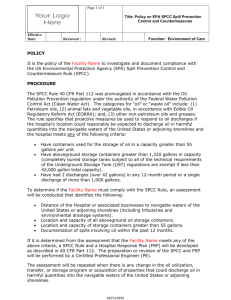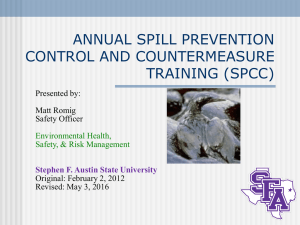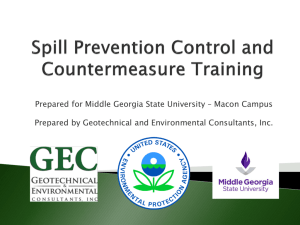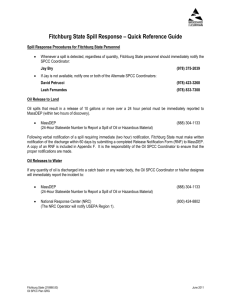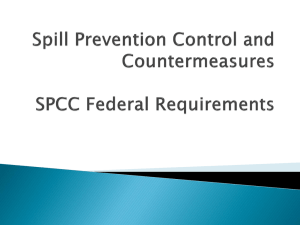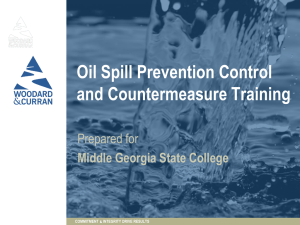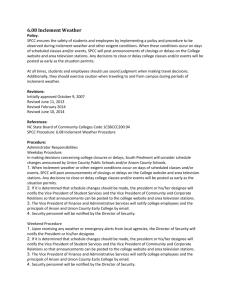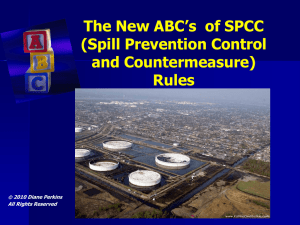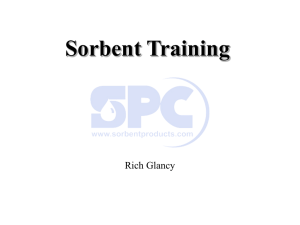Save your projects thousands by knowing if your facility needs a
advertisement
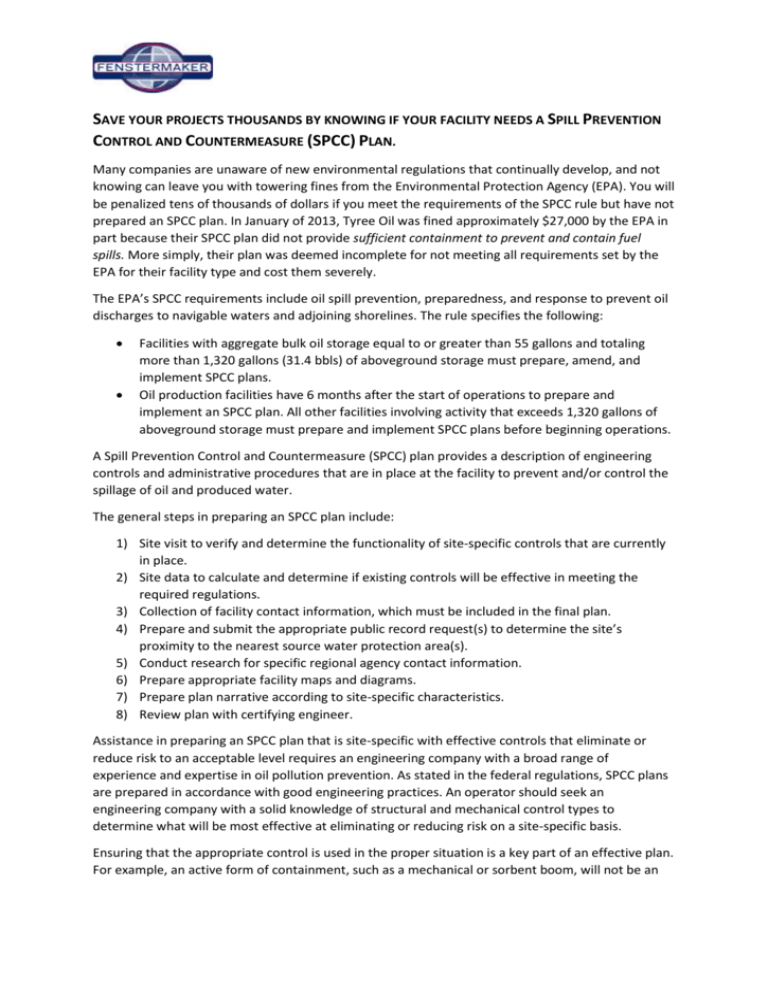
SAVE YOUR PROJECTS THOUSANDS BY KNOWING IF YOUR FACILITY NEEDS A SPILL PREVENTION CONTROL AND COUNTERMEASURE (SPCC) PLAN. Many companies are unaware of new environmental regulations that continually develop, and not knowing can leave you with towering fines from the Environmental Protection Agency (EPA). You will be penalized tens of thousands of dollars if you meet the requirements of the SPCC rule but have not prepared an SPCC plan. In January of 2013, Tyree Oil was fined approximately $27,000 by the EPA in part because their SPCC plan did not provide sufficient containment to prevent and contain fuel spills. More simply, their plan was deemed incomplete for not meeting all requirements set by the EPA for their facility type and cost them severely. The EPA’s SPCC requirements include oil spill prevention, preparedness, and response to prevent oil discharges to navigable waters and adjoining shorelines. The rule specifies the following: Facilities with aggregate bulk oil storage equal to or greater than 55 gallons and totaling more than 1,320 gallons (31.4 bbls) of aboveground storage must prepare, amend, and implement SPCC plans. Oil production facilities have 6 months after the start of operations to prepare and implement an SPCC plan. All other facilities involving activity that exceeds 1,320 gallons of aboveground storage must prepare and implement SPCC plans before beginning operations. A Spill Prevention Control and Countermeasure (SPCC) plan provides a description of engineering controls and administrative procedures that are in place at the facility to prevent and/or control the spillage of oil and produced water. The general steps in preparing an SPCC plan include: 1) Site visit to verify and determine the functionality of site-specific controls that are currently in place. 2) Site data to calculate and determine if existing controls will be effective in meeting the required regulations. 3) Collection of facility contact information, which must be included in the final plan. 4) Prepare and submit the appropriate public record request(s) to determine the site’s proximity to the nearest source water protection area(s). 5) Conduct research for specific regional agency contact information. 6) Prepare appropriate facility maps and diagrams. 7) Prepare plan narrative according to site-specific characteristics. 8) Review plan with certifying engineer. Assistance in preparing an SPCC plan that is site-specific with effective controls that eliminate or reduce risk to an acceptable level requires an engineering company with a broad range of experience and expertise in oil pollution prevention. As stated in the federal regulations, SPCC plans are prepared in accordance with good engineering practices. An operator should seek an engineering company with a solid knowledge of structural and mechanical control types to determine what will be most effective at eliminating or reducing risk on a site-specific basis. Ensuring that the appropriate control is used in the proper situation is a key part of an effective plan. For example, an active form of containment, such as a mechanical or sorbent boom, will not be an effective measure if the facility is unmanned. Therefore, the use of a passive form of containment, such as the construction of an earthen or concrete dike, will be required. Often, operators are unaware that produced water tanks and process vessels are required to have sized secondary containment because they fall under the general classification of “bulk oil storage containers.” For example, if your process area contains two Heater Treaters, three Separators, and three 55gallon drums of engine oil, a structural control such as a limestone/earthen berm will be required to contain at least 110% of the volume of the largest container. This can be accomplished by constructing one or more berms to surround these regulated containers. A cross-trained team of engineers and technical experts is crucial to the development of an effective SPCC plan that meets both federal requirements and the needs of the facility. These specialists should have a working knowledge of engineering (structural and mechanical) and work practice (procedures and policies) controls. An established SPCC plan must be reviewed every five years. In addition, the plan must be amended if there are any modifications in the facility design, construction, storage capacity, operation, or maintenance. Such facility modifications render the existing plan inadequate. If needed, your engineering consultant can assist clients in confirming these requirements during the process. Having a properly prepared SPCC plan demonstrates that a company is committed to the prevention of oil discharge into the environment and maintains the highest standards for spill prevention control. The company is recognized for taking countermeasures against such incidents through regular review, updates, and implementation of the SPCC plan for its facility. An accurate, comprehensive SPCC plan that addresses all of the requirements for a specific site demonstrates the company’s commitment of manpower and resources to expeditiously respond, control, and clean up a potential spill. As part of the Fenstermaker Environmental team, William Riehl, AEP is a Regulatory Specialist and brings years of experience in researching and developing processes and procedures for preparing site specific SPCC plans. With a Bachelors of Science in Industrial Technology from the University of Louisiana at Lafayette (formerly the University of Southwest Louisiana), Mr. Riehl has continued building his expertise, including obtaining certification as an Associate Environmental Professional (AEP) through the National Registry of Environmental Professionals (NREP). During his time at Fenstermaker, he has attended various training events presented by the United States Environmental Protection Agency (EPA), the United States Coast Guard (USCG), and the Louisiana Oil Spill Coordinator’s Office (Office of the Governor) to remain updated in his field. Established in 1950, Fenstermaker is a multi-disciplinary industry specializing in survey & mapping, engineering, environmental, and advanced technology services. With over 300 team members in various office and field locations throughout the U.S., Fenstermaker’s diverse portfolio of expertise and experience serves a wide market reach. The company focuses on remaining at the forefront of technology and new techniques to provide innovative solutions and quality services to our clients. Committed to collaborating within disciplines to ensure project efficiency, our team works together towards a shared vision of being a vital partner in the success of our clients. For more information about Fenstermaker’s specialized services, visit www.fenstermaker.com or call 337.237.2200.
